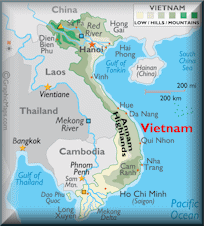-
-

Please Wait...
-
.vn Vietnamese Domain Country Information - .vn Vietnam Country Information
.vn

Price and Requirements for .vn Domains
Registration Pricing
- 1 Year 159.00 USD
- 2 Years 318.00 USD
Application Fee
25.00 USD
Registration Time Frame
1 Day
Requirements
No Details Are Individual .vn domain registrations allowed?
Yes Details Company or legal entities registrations allowed for .vn?
Yes Details Are there requirements, documents, or information needed for .vn?
Yes Details Are some .vn domain names restricted?
No Details Does .vn domain have a special use?
No Details Other information I need to know about .vn?
Yes Details Are there any additional fees for .vn?
No Details Do I need a trademark/brand name to register .vn?
No Details WHOIS Privacy service available?
![]() Trustee / Proxy service offered? Fees?
No
Details
Trustee / Proxy service offered? Fees?
No
Details
.vn Vietnam Country Information
Vietnam, officially the Socialist Republic of Vietnam, is the easternmost country on the Indochina Peninsula in Southeast Asia. It is bordered by China to the north, Laos to the northwest, Cambodia to the southwest, and the South China Sea to the east. With a population of over 85 million, Vietnam is the 13th most populous country in the world.
Vietnam was under Chinese control for a thousand years before becoming a nation-state in the 10th century. Successive dynasties flourished until it was colonized by the French in the mid-19th century. Efforts to resist the French eventually expelled the French from the country in the mid-20th century, leaving a nation divided politically into two countries. Bitter fighting between the two sides continued during the Vietnam War, ending with a communist victory in 1975.
Emerging from a long and bitter war, the war-ravaged nation was politically isolated. The government's centrally-planned economic decisions hindered post-war reconstruction and its treatment of the losing side engendered more resentment than reconciliation. In 1986, it instituted economic and political reforms and began a path towards international reintegration. By 2000, it had established diplomatic relations with most nations. Its economic growth had been among the highest in the world in the past decade. These efforts culminated in Vietnam joining the World Trade Organization in 2007 and its successful bid to become a non-permanent member of the United Nations Security Council in 2008.
Vietnam is approximately 331,688 km² (128,066 sq mi) in area (not including Hoang Sa and Truong Sa islands), larger than Italy and almost the size of Germany. The perimeter of the country running along its international boundaries is 4,639 km (2,883 mi). The topography consists of hills and densely forested mountains, with level land covering no more than 20%. Mountains account for 40% of the area, with smaller hills accounting for 40% and tropical forests 42%. The northern part of the country consists mostly of highlands and the Red River Delta. Phan Xi P?ng, located in LàoCai province, is the highest mountain in Vietnam at 3,143 m (10,312 ft). The south is divided into coastal lowlands, Annamite Chain peaks, extensive forests, and poor soil. Comprising five relatively flat plateaus of basalt soil, the highlands account for 16% of the country's arable land and 22% of its total forested land.
The delta of the Red River (also known as the SôngH?ng), a flat, triangular region of 15,000 square kilometers, is smaller but more intensely developed and more densely populated than the Mekong River Delta. Once an inlet of the Gulf of Tonkin, it has been filled in by the enormous alluvial deposits of the rivers over a period of millennia, and it advances one hundred meters into the Gulf annually. The Mekong delta, covering about 40,000 square kilometers, is a low-level plain not more than three meters above sea level at any point and criss-crossed by a maze of canals and rivers. So much sediment is carried by the Mekong's various branches and tributaries that the delta advances sixty to eighty meters into the sea every year.
Because of differences in latitude and the marked variety of topographical relief, the climate tends to vary considerably from place to place. During the winter or dry season, extending roughly from November to April, the monsoon winds usually blow from the northeast along the China coast and across the Gulf of Tonkin, picking up considerable moisture; consequently the winter season in most parts of the country is dry only by comparison with the rainy or summer season. The average annual temperature is generally higher in the plains than in the mountains and plateaus and in the south than in the north. Temperatures in the southern plains (Ho Chi Minh City and the Mekong Delta) varies less, going between 21 and 28 degree Celsius (70 and 82.5 °F) over the course of a year. The seasons in the mountains and plateaus and in the north are much more dramatic, and temperatures may vary from 5 degree Celsius (41 °F) in December and January to 37 degree Celsius (98.6 °F) in July and August.
.vn Vietnam Domain Name - Country Information
| Country Domain | Vietnam Domain Name .vn |
|---|---|
| Country Information | Vietnam Domain Country Information .vn |
| TLD Bulk & Advanced Search | Vietnam Bulk Domain Registration .vn |
| WhoIs Server | .vn Whois Server Information |
| Domain Renewals | Renewal Vietnamese Domain .vn |
| Domain Transfer | Transfer Domain .vn |
| Domain Hosting | .vn Vietnam Web Hosting |
| SSL Certificates | SSL Certificates |
| Email Services | .vn Vietnam Email Services |
| Domain FAQ | .vn Domain Registration FAQ |
Vietnam Country Information Search Terms
Vietnamese Domain Country Information Vietnamese Domain Registrar Vietnamese World Wide Domain Registration Vietnamese Country Code Top Level Domain .vn Domain Information Vietnamese Country Information Vietnam Country Information














